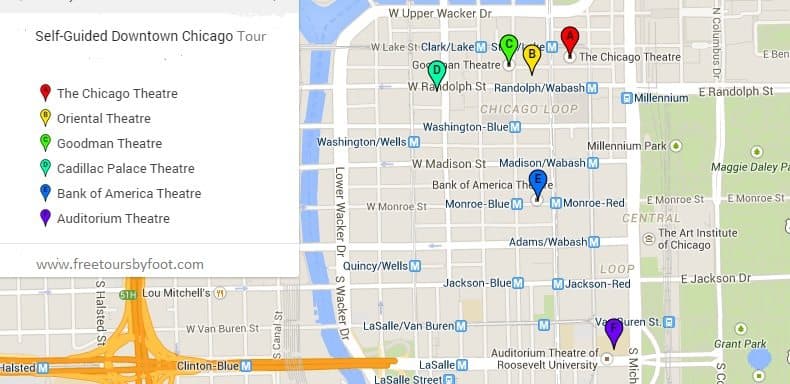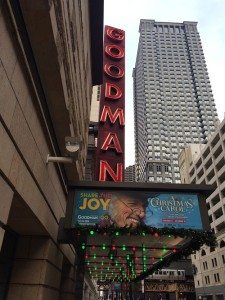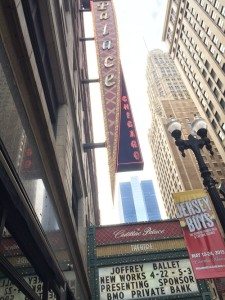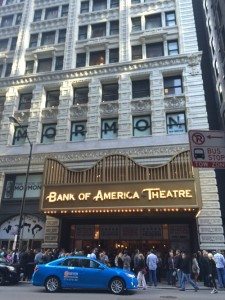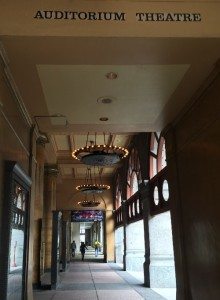This tour will explore the downtown Theater District and the gorgeous architecture of the old movie palaces and concert venues. There are many other gorgeous theater buildings and incredible theater companies in other areas of Chicago.
Be sure to also check out our full selection of self-guided tours of Chicago.
++Tip: If you are looking to attend a show or concert, check out our blog on Theater Discount Tickets. It's worth checking out Goldstar, Groupon or LivingSocial, for special deals and discounts on Theater and Show tickets in Chicago.++
Start: 175 N. State Street in front of the Chicago Theater
Nearest El Stop: State and Lake (All trains except Blue)
Click for movable map.
The Chicago Theatre 175 N. State Street
The Chicago Theatre was designed as a movie palace in French Baroque style in 1921 by the architecture firm famous for theatre design: Rapp & Rapp. The exterior of the building features a replica of the Arc de Triomphe in Paris. Along the arc- look for the masks on either side representing the drama faces of comedy and tragedy. In the stained glass window, you will see two horse holding ribbons of 35-mm film in their mouths. This is the coat of arms for Balaban and Katz, the founders of a theatre chain. The marquee is a landmark in itself. It was replaced with a replica in 2004 and the original is now owned by the Smithsonian. The Chicago Theatre played films and occasionally live music faithfully until the theatre was closed in 1985 due to the economy and social changes along State Street. Luckily, it reopened in 1986 with a stunning concert starring Frank Sinatra. Since then, the Chicago Theatre usually hosts comedians, musicians, and sometimes a Broadway tour.
Directions: Walk south on State Street and turn right on Randolph. You will see the Oriental Theatre Marquee. (About 3 minutes.)
Oriental Theatre 24 W. Randolph Street
The Oriental stands in the place of the Iroquois Theatre that burned down in 1903. It was built in 1926 by Rapp & Rapp in the Gothic Revival style. The name “Oriental” was given represent the interior which is inspired by the Far East with Asian and Indian Art. The auditorium is meant to resemble a hasheesh-dream. When sitting in the seats of this theatre, you’ll find many hidden treasures in the design including elephants, Buddhas, and a gentleman rolling a pair of dice representing risk and chance. The theatre closed its doors in 1981, but thanks to Mayor Daley reopening in 1996.
Directions: Head west on Randolph Street and cross Dearborn Avenue. You will see the Goodman immediately. (About 2 minutes.)
Goodman Theatre 170 N. Dearborn Street
The Goodman Theatre is Chicago’s oldest active not for profit regional theatre. It was founded in 1925 and was originally located as a part of the Art Institute building but moved in 2000 to their new home on Dearborn. This location used to be the Harris and Selwyn Theatres which were designed by Sam H. Harris and Archie and Edger Selwyn in 1922. The exterior of the building remains the same but the interior was renovated and completely modernized. The lobby is usually open during office hours if you’d like to take a peek. Look for the unique skylight in the middle of the lobby and see if you can see the “G” from the Goodman marquee through the skylight.
Directions: Head back to Randolph and take a right. The Cadillac Palace is on the South side of the street. Look for its giant marquee. (About 4 minutes.)
Cadillac Palace 151 W. Randolph Street
The New Palace Theatre opened in 1926 as a vaudeville stage, concert venue and later movie house. It was designed by Rapp & Rapp. The interior of the building is a French Renaissance style with ornate brass mirrors and chandeliers. Brass details inside were all painted white to disguise the material during World War II when many buildings were required to give up their brass to be melted for the war. Some notable premiers include: The Color Purple, The Producers, and Aida.
Directions: Head east on Randolph (passing the Oriental Theatre on your left) and take a right at State Street. Take a Left onto Monroe and look for the theatre on the right. (About 7 minutes.)
Bank of America Theatre 18 W. Monroe Street
The Bank of America Theatre was formally the Shubert and the Majestic. It opened in 1906 as The Majestic Theatre which was named after the building it is housed in. This beaux-arts style structure was designed by Edmund C. Krause. At the time, George Leslie Rapp was a draftsman and designer for Krause, though later he would start his own architecture firm with his brother called Rapp & Rapp. Since it was the first theatre built after the Iroquois Theatre Fire, many measures to ensure safety were installed. The interior of the building was known to be ornate with bright vibrant colors to attract wealthier patrons. The Majestic was originally a vaudeville theatre featuring headliners like Eddie Foy, Harry Houdini, and Fanny Brice. During the Great Depression, the theatre closed and didn’t reopen until 1945 as the Shubert. Currently this theatre is a part of Broadway in Chicago and is a Broadway touring house or hosts pre-Broadway trial shows. Some notable productions include: The pre-Broadway trial of High School Musical, the pre-Broadway trial of Monty Python’s Spamalot and the pre-Broadway trial of Cyndy Lauper’s Kinky Boots.
Directions: Head west on Congress (toward Wabash) and turn right onto State Street. Then turn left on Monroe and the Auditorium will be on your right. (About 10 minutes)
Auditorium Theatre 50 E. Congress
The Auditorium building was designed by Adler and Sullivan in 1889 to be an opera house. It was designed in the Romanesque Revival style with massive stone wall and circular arches. At the time, the Auditorium was the tallest building in Chicago. It is a load bearing building with thick blocks of granite. On the south side of the building, the sidewalk is under part of the structure. This is a section of the building that used to be the theatre’s bar but was re-envisioned when the city needed the sidewalk space. The building is now owned by Roosevelt University. In 1947, the university “acquired” it for $1 plus back tax payments. Notable events: The 1888 National Republican Convention was held there even though the building wasn’t complete and the Chicago Symphony Orchestra debuted in 1904.
+++Check out our pay-what-you-like walking tours of Chicago, if you prefer a real guide to lead you through this magnificent city!+++






